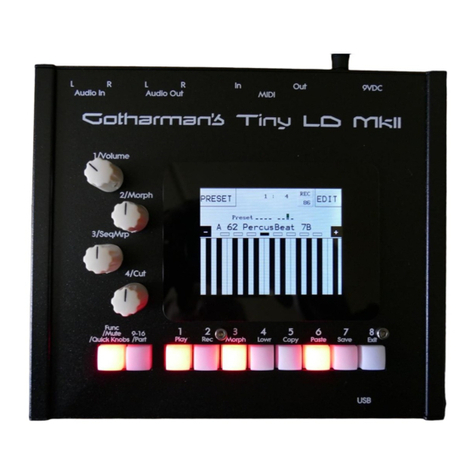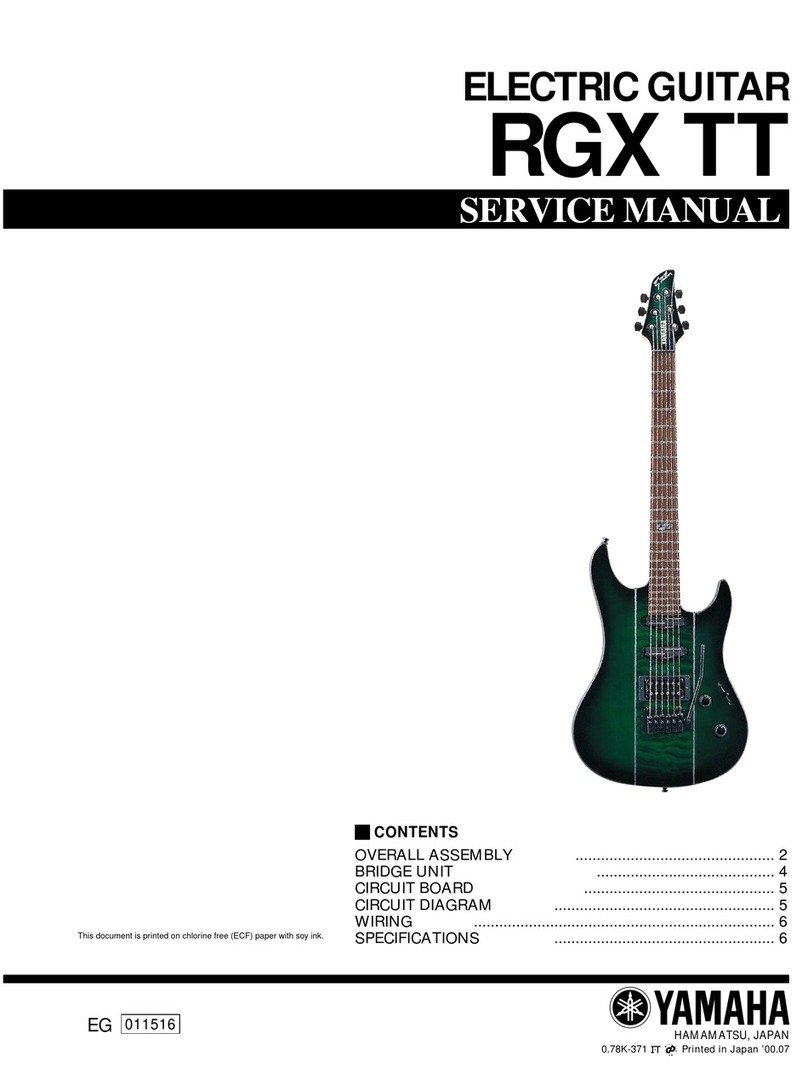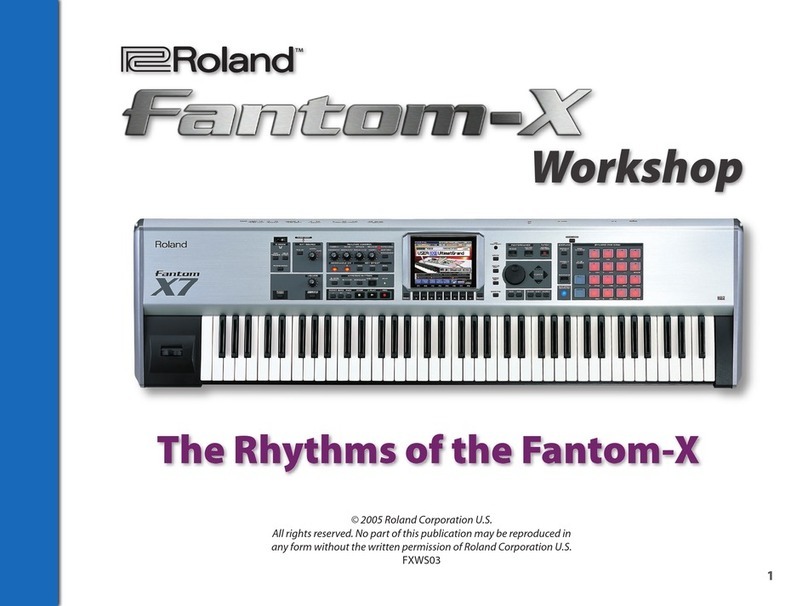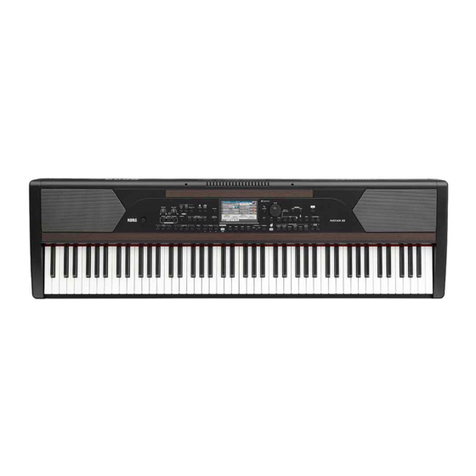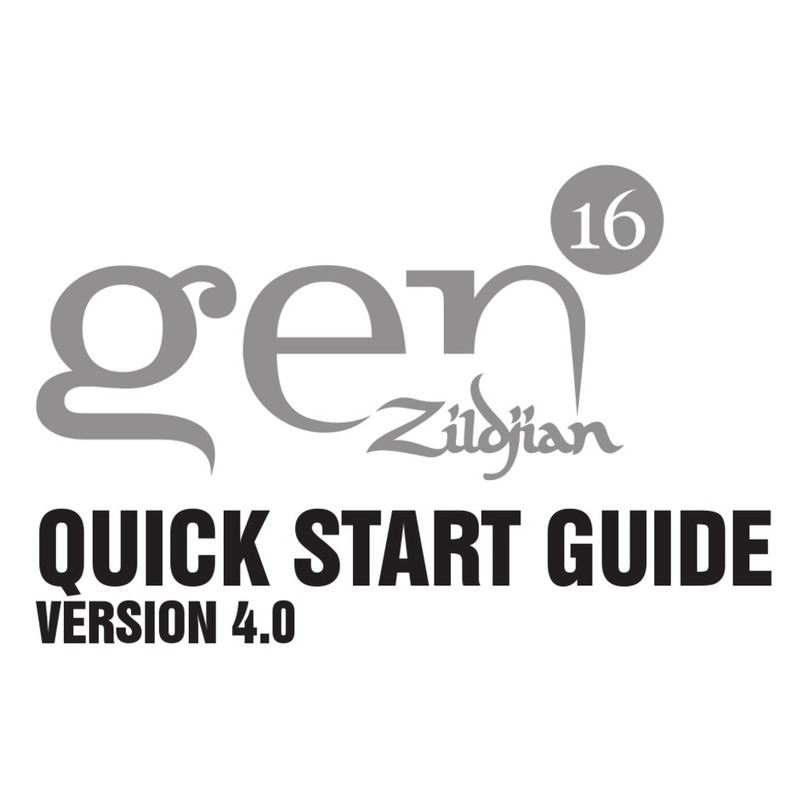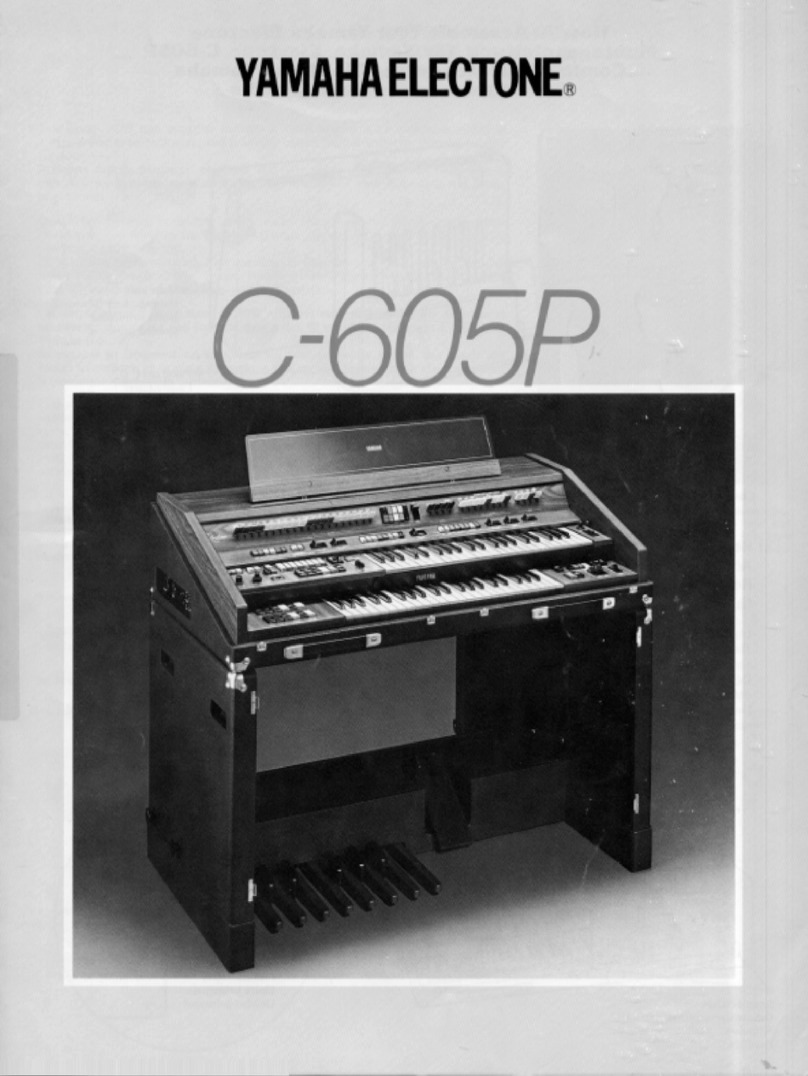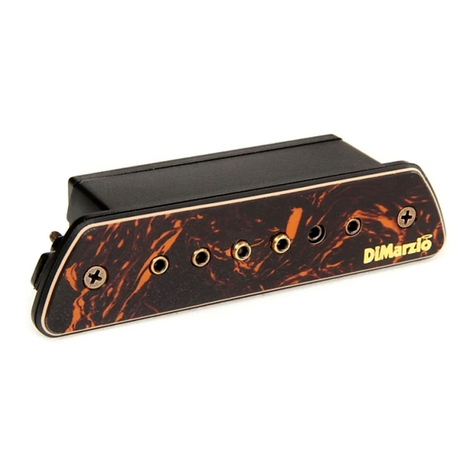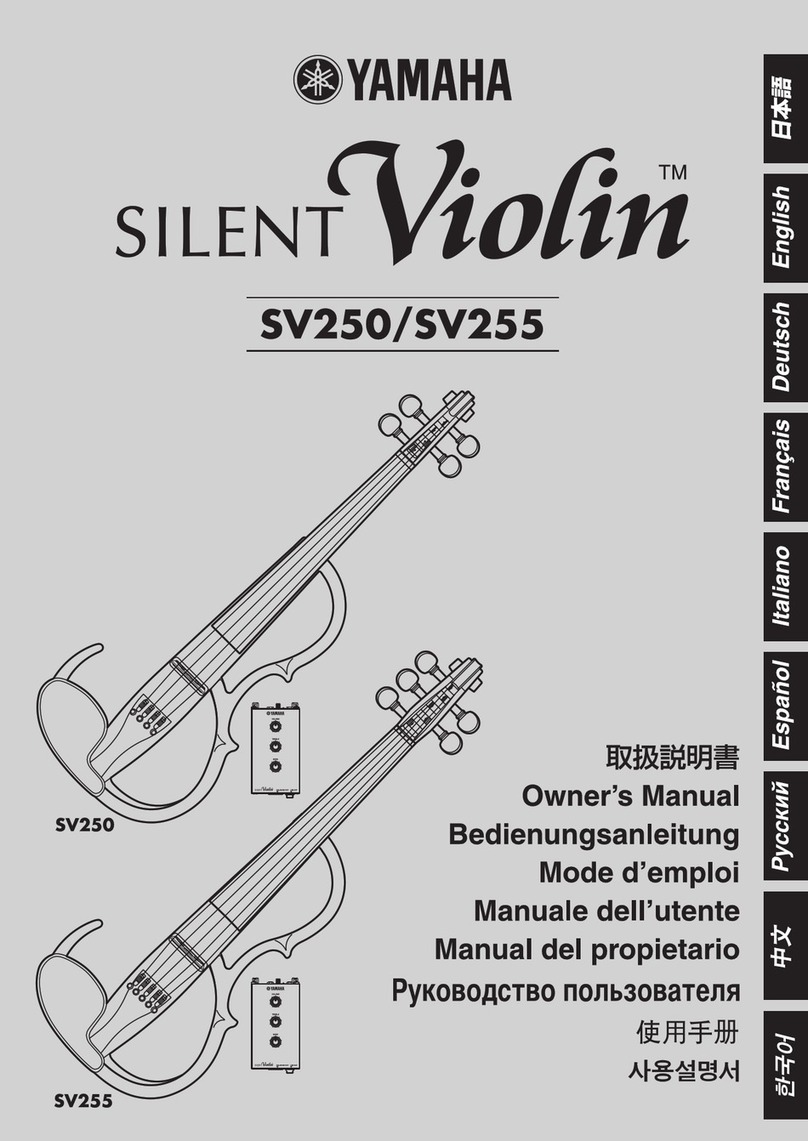Gotharman Little deFormer 3 User manual

1
Gotharman’s Little deFormer
3
Granular Workstation
User Manual V10.26

2
Content Of This Manual
Introduction 9
Very Special Thanks To 11
In The Box 12
Getting Started 13
User Interface 20
Preset Select Screen 23
Operating LD3 27
Starting/stopping Sequencer/trigger parts manually 27
Selecting a Part 28
Selecting Effects Processors 28
Note Tracks Steps view/edit 29
Selecting Note Track Steps 30
Setting Note Track Last Step 31
Mute/Unmute Note Tracks 32
Copy Morph Layer A to B 33
Selecting the next Preset 33
Selecting the previous Preset 34
Selecting Presets using step buttons 35
Preset Reload 36
Panic 36
Compare Preset 37
Shortcuts to Edit Pages 38
Audio Bus System 40
LD3 Structure 41

3
Synth/Sampler Parts 42
Modulation Sources 43
Accessing The Synth Part Pages 50
Editing The Parameters 52
Parameters Randomizer 53
Trigger Setup 55
Zone Setup 57
Audio Bus Setup 58
Oscillator/Sampler/Noise 64
Granular Modulators 76
Random Generators 78
Digital Filters 79
VCA 88
Envelope 1 and 2 92
LFO 1 to 16 96
Audio Inputs Setup 99
Analog FilterBoards 100
SPAZEboard 2 114
Effects Processors 136
Insert Effects 1 to 8 138
List of Insert Effects 139
Insert Effects Select Page 141
Mix Modulation and Backwards 143
Chorus 145
Distortion 147
Bit Crush 149
Pitch Shifter 151
Resonator 154
Stretcher 156
FM 158
Glitch Shifter 1, 2 and 3 160
Pitch Shaper 162
FAT 164
Filters 166
Filters 2 169
Compressor 171
Expandor 173
PitchShaper2 174
Delays 178

4
Variator 180
Time Stretch 182
Sample Pitch 184
Output Effects 1 and 2 186
List of Output Effects 187
Output Effects Select Page 189
Mix/Pan Modulation and Backwards 192
Delays 194
Granulator SQ 197
Variator 200
Reverb 202
Granulator (unsynced) 204
Xfade Granulator 207
Abstruct0 210
Time Stretch 213
Sample Pitch 215

5
Sequencer 217
Entering The Sequencer 224
Sequencer Main 227
Clear Sequence 229
Note subtrack 230
Gate Time subtrack 233
Velocity subtrack 235
Position subtrack 237
Sub Position subtrack 239
Templates and Note Scales 241
Templates for Position subtrack 243
Note Track Mod page 245
Clear Note Track 247
Double Note Track 248
Realtime Recording of Notes 249
Step Recording of Notes 251
Track/Part Internal/External Operation 254
Audio Track Recording 257
Controller tracks 267
Controller Track templates 271
Controller Tracks CC page 273
Clear Controller Track 275
Double Controller Track 276
Adjusting The CV Scale 277
Controller Tracks Realtime recording 278
Recording Parameter Tweaks 281
CV Inputs Recording 282
Pitch Bend and CC recording auto setup 283
Controller Tracks Step Recording 285
Synth and Sequencer Morphing 286

6
More… Parameters/Setup 287
Common Settings 290
Morph Setup 292
Common Settings 2 296
CV Inputs 297
CV Outputs 300
Initialize Preset 303
Parameter Snap Mode 304
FilterBoards Setup 306
FLASH Memory Check 308
Delete Sample Bank 309
Delete All Presets and Songs 310
C.P. 311
Preset/Song Mode 312
Display Update Rate 313
Save Preset 314
Song Mode 318
Accessing Song Mode 319
Song Edit page 323
Song Select page 325
Song Realtime Recording 327
Save Song 331
Initialize Song 335
Copy/Paste 337
Sample Record and Edit 340
Recording a Sampling 341
Edit a Sampling 349
Adjusting Start/End Points 351
Sample Chops 352
Wave Chop System 356
Deleting Last Recorded Sampling 364
Deleting Other Samplings 366
Graphical Sample Editing 367
Wave Builder 380

7
USB 383
USB Sample Preview 385
Open A Directory 386
Importing Files 387
Importing Multiple Files 389
Reload Multiple Files 390
Import Samplings As Chops 392
Make a New Directory 395
Delete File From USB Drive 396
Export Samples, Presets and Songs 397
Updating LD3 Firmware 399
MIDI Specs 406
Parameters CC Control 408
List Of Parameter CC Numbers 410
Effects Parameters 1 and 2 413
Controlling Parameters From Controller Tracks 414
Safe Boot Mode 415
Installing/Exchanging Analog FilterBoards 416
Installing The Analog Board 434

8
I hope that you will deform some great tracks

9
Introduction
Thank you very much for purchasing/consider to purchase a Gotharman’s Little deformer 3.
Little deformer 3 (sometimes shortened to LD3) are a multi-timbral and polyphonic granular
workstation with 16 parts. The granular functions in it includes oscillator/sampler granular
modulators and special granular effects.
Each of the 16 parts has a stereo oscillator/sampler, 2 filters with 16 different filter types, a stereo
VCA, 3 envelopes, 4 random generators and 2 granular modulators, a random one and a
sequenced one. Additional modulation sources includes 16 global LFO’s, 32 sequencer controller
tracks, 8 audio bus envelope followers, touch screen keyboard Y position and MIDI keyboard,
velocity, aftertouch, pitch bend and CC’s.
The samplers can hold up to 193 minutes of samplings/ maximum 8.192 samplings. Samplings can
be chopped by level peaks, wave zero points, or in equally sized slices. Up to 64 chop points are
possible for each sampling. Samples are stored in FLASH memory, and played back directly from
this, so: No loading times!
Each part can be send to up to two of 8 audio busses at the same time. Pan modulation can
control the send level to each of the 2 busses.
On the audio busses up to 8 insert effects and 4 analog filters can be placed, for processing the
sounds from the parts and from its audio inputs. Up to 4 audio inputs are available (2 of them
optional).
The output from the audio busses can be sent to any of up to 4 audio outputs (2 of them optional)
and 2 output effect processors.
The 16 parts can be sequenced from a build-in sequencer, that has 16 note tracks, with up to 64
steps each, and 32 controller tracks, with up to 128 steps each. Each note track has a position
track, that makes it possible to alter the position of each step, making polyphonic step sequencing
and various direction modes possible. A sub position track is also available for micro timing.
Realtime, step time and xox style recording are possible. Knob movements and MIDI CC’s can be
recorded, both in realtime and step time on the controller tracks.
Both the note tracks and the controller tracks can also control external MIDI devices, with up to
128 notes of polyphony.
Audio tracks can be recorded on the note tracks. These can be instantly chopped for true
deforming manipulation.

10
The sound generating parts, the LFO’s, the effects processors and the sequencer has 2 layers of
parameter settings, layer A and layer B, that can be independently adjusted, and morphed
between, using the Morph and Seq Morph knobs.
All the parameter settings can be stored in any of 1024 rewritable preset locations, and recalled at
any time.
1024 song locations are available, for programmed playback of presets, and for tracks mute
automation.
I hope that you will enjoy your LD3 for a long time, and deform a lot of great tracks.

11
Very special thanks to:
Chris Curtis
Michael Dunkley
Weinglas
Don Linder
Nick Nimick
Franck Superbaby
Alban Loisil
Laurent Stehly
El-Kartoff
Cameron Scott Cairney
Ole-Jacob Sand
Michal Lichy
For supporting this project from the start. I sincerely appreciate your help.

12
In The Box
In the LD3 box should be:
-LD3 itself
-A power supply –Multi plug –Works in most countries.
If any of these items are missing, please get in touch with Gotharman’s.

13
Getting Started
Connecting:
On the right end panel of your LD3, you will find the power switch, connection for power supply,
stereo audio outputs, USB, and MIDI in and out.
You would probably like to connect the audio outputs to a mixer or an amplifier, or anything else
that ends out in a speaker/a set of speakers. Since LD3 doesn’t have built in speakers, it just needs
to be connected to something, that can transfer its amazing sound to you. These should be
connected, using ¼” mono jack cables.
The left audio output (marked “AUDIO OUT L(hp)) doubles as a stereo headphone connector.
Please make sure that nothing is connected to the right audio output, when plugging headphones
into this connector.
If the LD3 touch screen keyboard and step buttons seems a bit too limited, you might want to
connect a MIDI keyboard to MIDI in, in order to take full advantage of LD3’s fully chromatically

14
playable sounds. It is also possible to connect anything that transmits a MIDI clock, if you would
like the sequencer of LD3 to sync to the rest of your setup.
On MIDI out, MIDI clock, MIDI CC’s from the LD3 edit knobs, and notes and CC’s from its
sequencer are transmitted. Connect any MIDI gear to this, that you would like to control from LD3.
To the USB connector, a USB drive can be connected.
This should be:
-Maximum 32 GB
-FAT formatted
With a USB drive connected, you can:
-Import, export and back up samples as .wav files
-Import deFormer .lds samples
-Import, export and back up LD3 presets and songs
-Update LD3
-PLEASE NOTICE: The included factory samples CANNOT be exported. So if you want to keep these,
you should take care not to delete them. A USB stick with the factory samplings might be available
in the future.
To import a .wav file from another device, it must be:
-Mono or stereo
-44.1 KHz sample rate –LD3 will import other sample rates, but they will play back in a wrong
speed
-16 bit or 24 bit native PCM
-Standard wav’s or broadcast wav’s

15
On the left end panel of your LD3, you will find the stereo audio inputs. The optional extra audio
inputs and outputs and the CV inputs and outputs are also found here, if installed.
Audio inputs L and R
The two rightmost 1/4” jack connectors, marked “AUDIO IN R L” are always the stereo audio
inputs.
Connect any line stereo/mono audio sources to the audio input, for sampling and/or processing
through LD3’s effects and optional analog filters.
When 2 extra audio inputs and 2 extra audio outputs were ordered:
AUDIO IN/OUT 3 4 are the additional audio inputs 3 and 4, and AUDIO IN/OUT 5 6 are the
additional audio outputs 3 and 4.

16
With SPAZEboard2 installed:
AUDIO IN/OUT 3, 4, 5 and 6 are separate audio outputs from analog VCF 1, 2, 3 and 4. For VCF 2
and 3, only the filterboards output 1 are outputted here.
When 4 extra audio inputs and 4 extra audio outputs were ordered:
The tip of AUDIO IN/OUT 3, 4, 5 and 6 are audio inputs 3 to 6, the ring of AUDIO IN/OUT 3, 4, 5 and
6 are audio outputs 3 to 6.
CV inputs and outputs
If you start counting from the left, the first 4 minijacks are CV input 1 to 4. The next 4 are CV
output 1 to 4.
Connect any CV voltage source to the 4 CV inputs. Each input can be set up to match the voltage
range of any CV source, up to +/- 15 volts. The CV inputs can be set up to modulate many
parameters and they can be set up to act as trigger sources. They also accepts clocks, start/stop
and reset pulses for the sequencer.
Via the CV outputs it is possible to control analog gear. Each CV output, outputs both an adjustable
static voltage, plus an LD3 modulation source, so it is possible to both adjust t.ex. the cutoff
frequency of a connected analog filter, and to add modulation to this. It is also possible to output
triggers via these, to trigger external gear.
With SPAZEboard2 installed, the CV outputs are:
1: VCF3 Feed parameter and modulation.
2: VCF3 Reso parameter and modulation.
3: VCF3 Cut parameter and modulation.
4: VCF3 Peaks parameter and modulation.

17
Starting Up
Connect the supplied power adaptor to the Power input, and to a 100V to 240V power source –
Usually a wall socket.
It’s a 9V, minimum 2.0A type with a 2.1 mm DC plug, with positive middle. The power supply on
the picture is only for reference. The actual one might look different.
Some LD3’s might have been shipped out with a power adaptor, that has multiple tips. If you have
received one of these, you should use the tip with the blue ring, and make sure that the 2 parts
are alligned to the text “Tip”:
Please look at the picture, on the next page….

18

19
Turn it on
Push the “I” on the power switch. Your LD3 should now turn on.

20
The User Interface
LD3 has a highly sensitive and responsive capacitive touch display, 16 step/trigger/part
select/quick jump buttons, a Morph Set button, a Func/Mute button, a Steps/Part button and a
Sequencer Start/Stop button. It has 8 Edit/Quick Edit Knobs for controlling and editing parameters
and sending MIDI CC’s, a (synth) Morph knob, a Sequencer Morph knob and a volume knob.
Pushing the Trigger 1-16 buttons, with Func/Mute and Steps/Part unlit, will trigger the respective
LD3 part. Each trigger button will send a settable note number (Settable in the Synth “Trig””
section). When a trigger is trigged, the button will light up.
The Start/Stop button will start and stop Sequencer playback. When the sequencer is playing
back, the Start/Stop button will light up.
The Morph Set button, will toggle the parameters on any Synth and Sequencer page, between 2
layers of parameters, A and B. The Morph knob (MIDI CC#1) will morph between the two layers of
Synth parameters, and the Seq Morph knob (MIDI CC#2) will morph between the two layers of
Sequencer parameters.
Other manuals for Little deFormer 3
5
This manual suits for next models
1
Table of contents
Other Gotharman Musical Instrument manuals
Popular Musical Instrument manuals by other brands

Panasonic
Panasonic SXPX665 - ELECTRONIC PIANO operating manual
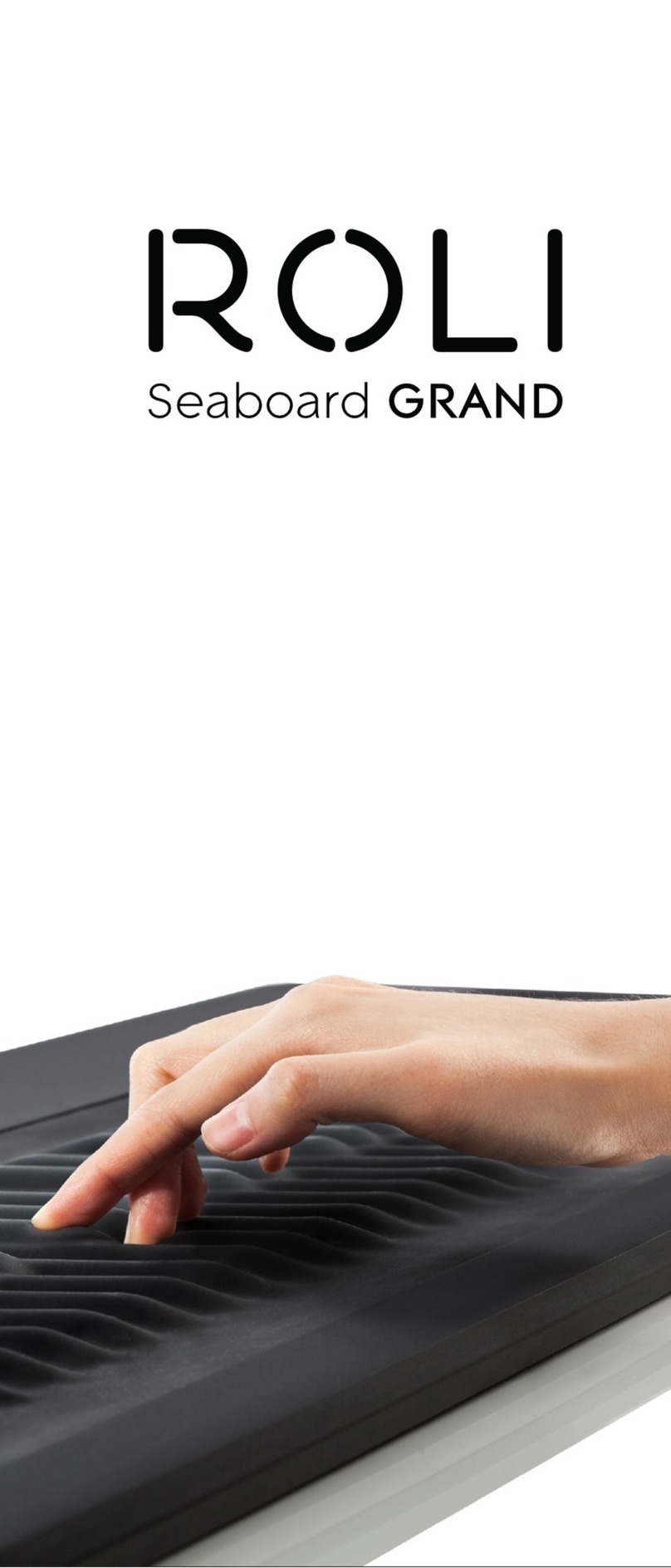
Roli
Roli seaboard grand Assembly instructions
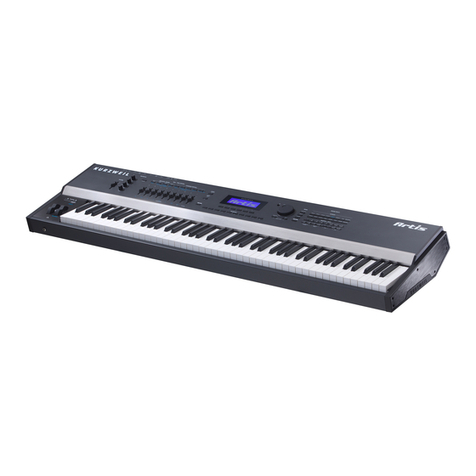
Kurzweil
Kurzweil Artis Musician's guide

Allen Organ Company LLC
Allen Organ Company LLC Renaissance GW4 owner's manual

BYO Guitar
BYO Guitar Lunatic Assembly instructions
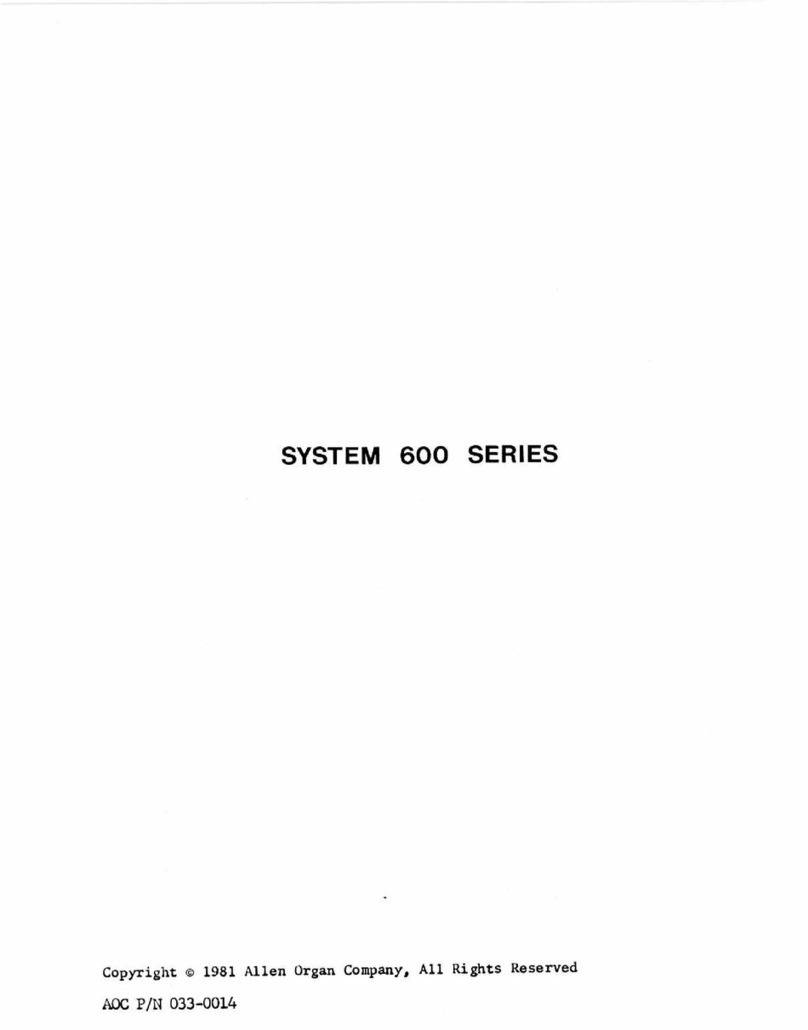
Allen Organ Company LLC
Allen Organ Company LLC System 600 Series owner's manual
